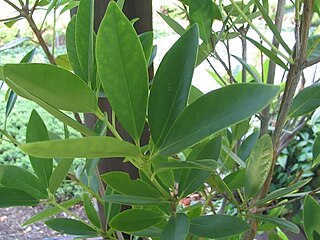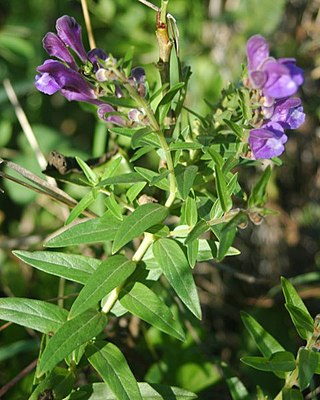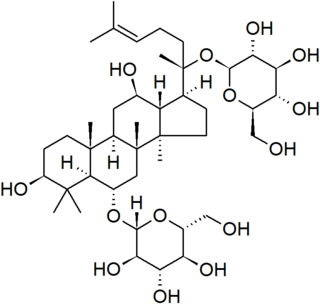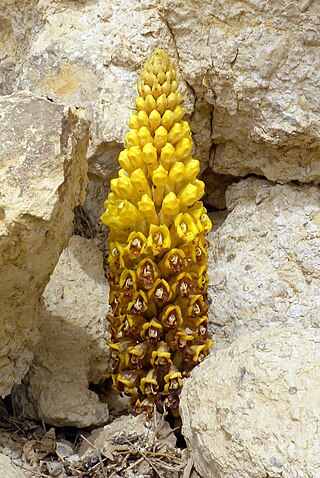
Traditional Chinese medicine (TCM) is an alternative medical practice drawn from traditional medicine in China. It has been described as pseudoscientific, with the majority of its treatments having no known mechanism of action.

Illicium verum is a medium-sized evergreen tree native to northeast Vietnam and South China. It is a spice that closely resembles anise in flavor and is obtained from the star-shaped pericarps of the fruit of I. verum which are harvested just before ripening. Star anise oil is a highly fragrant oil used in cooking, perfumery, soaps, toothpastes, mouthwashes, and skin creams. Until 2012, when they switched to using genetically modified E. coli, Roche Pharmaceuticals used up to 90% of the world's annual star anise crop to produce oseltamivir (Tamiflu) via shikimic acid.

Angelica sinensis, commonly known as dong quai or female ginseng, is a herb belonging to the family Apiaceae, indigenous to China. Angelica sinensis grows in cool high altitude mountains in East Asia. The yellowish brown root of the plant is harvested in the fall and is a well-known Chinese medicine which has been used for thousands of years.

Scutellaria baicalensis, with the common name Baikal skullcap or Chinese skullcap, is a species of flowering plant in the family Lamiaceae.

Astragalus mongholicus, synonyms including Astragalus propinquus and Astragalus membranaceus, commonly known as Mongolian milkvetch in English; 'Хунчир' in Mongolian; huáng qí, běi qí or huáng huā huáng qí, in Mongolia, is a flowering plant in the family Fabaceae. It is one of the 50 fundamental herbs used in traditional Mongolian medicine. It is a perennial plant and it is not listed as being threatened.

Ginsenosides or panaxosides are a class of natural product steroid glycosides and triterpene saponins. Compounds in this family are found almost exclusively in the plant genus Panax (ginseng), which has a long history of use in traditional medicine that has led to the study of pharmacological effects of ginseng compounds. As a class, ginsenosides exhibit a large variety of subtle and difficult-to-characterize biological effects when studied in isolation.

Cistanche deserticola is a holoparasitic member of the plant family Orobanchaceae, commonly known as desert-broomrape.

Cistanche is a worldwide genus of holoparasitic desert plants in the family Orobanchaceae. They lack chlorophyll and obtain nutrients and water from the host plants whose roots they parasitize. They are often known as desert hyacinths.

Wikstroemia indica, also known as tie bush, Indian stringbush, bootlace bush, or small-leaf salago is a small shrub with glossy leaves, small greenish-yellow flowers and toxic red fruits. It grows in forests and on rocky, shrubby slopes in central and southeastern China, Vietnam, India, Australia and the Philippines.

Ampelopsin, also known as dihydromyricetin and DHM, when purported as an effective ingredient in supplements and other tonics, is a flavanonol, a type of flavonoid. It is extracted from the Japanese raisin tree and found in Ampelopsis species japonica, megalophylla, and grossedentata; Cercidiphyllum japonicum; Hovenia dulcis; Rhododendron cinnabarinum; some Pinus species; and some Cedrus species, as well as in Salix sachalinensis.

The tolai hare is a species of hare native to Central Asia, Mongolia, and Northern and Central China. It inhabits semi-desert, steppes, rocky habitats, and forest meadows. It is relatively common, even in areas with heavy human disturbance, due to its fast reproductive rate. It is mainly active at dusk and at night but is occasionally active during the day.

Huáng bǎi, huáng bó or huáng bò is one of the fifty fundamental herbs of traditional Chinese medicine. Known also as Cortex Phellodendri, it is the bark of one of two species of Phellodendron tree: Phellodendron amurense or Phellodendron chinense.
Cāng zhú, also known as black atractylodes rhizome or Rhizoma Atractylodes, is a Chinese herbal medicine. It is the dried rhizome of Atractylodes lancea (Thunb.) DC., synonyms Atractylodes chinensis (DC.) Koidz, and Atractylodes japonica Koidz. The medicine is distinguished from bái zhú, which is typically cultivated, whereas cāng zhú more often tends to be collected from the wild. It is believed that the distinction between cāng zhú and bái zhú emerged in relatively modern times; a single drug "zhú" described in the Shen nong ben cao jing probably included many Atractylodes species.

Phillyrin is an endophytic fungal isolate with anti-obesity activity. It can be produced by Colletotrichum gloeosporioides, an endophytic fungus isolated from Forsythia suspensa. It can also be prepared directly from Forsythia suspensa.
Corydalis yanhusuo is a plant species in the genus Corydalis. The Chinese name for Corydalis yanhusuo is yan hu suo. The Japanese common name is engosaku (エンゴサク) and the Korean common name is hyeonhosaek (현호색). English common names include yanhusuo, corydalis, and Asian corydalis. The tuber of this plant, frequently mislabeled as the root, is an important therapeutic agent in traditional Chinese medicine. It is native to high-altitude grasslands across China including in the provinces of Anhui, Henan, Hubei, Hunan, Jiangsu, and Zhejiang, but is more widely cultivated.
C. tubulosa may refer to:
Nan Bao (男宝) is a formula of Chinese herbs purported to increase the male libido. It is available from a variety of suppliers in similar formulations.

Xiyanping (喜炎平) is an anti-inflammatory and antiviral preparation developed and licensed for use in China. It is a semi-synthetic injectable product derived from the active component of the plant Andrographis paniculata, which is used in Traditional Chinese medicine. Xiyanping is primarily composed of 9-dehydro-17-hydro-andrographolide and sodium 9-dehydro-17-hydro-andrographolide-19-yl sulfate. It is used mainly in the treatment of hand, foot and mouth disease, diarrhea, upper respiratory tract infections and viral pneumonia, though one case report suggested it may also be useful in the treatment of Zika fever.

Phlomoides tuberosa, the sage-leaf mullein, is a perennial herbaceous flowering plant in the family Lamiaceae, native to China, Kazakhstan, Kyrgyzstan, Mongolia, Russia; SW Asia and Europe. Enlarged, tuberous roots give rise to erect stems to 150 cm bearing purple-red flowers.

Ligustilide is a natural chemical compound of the dihydrophthalide class. Ligustilide is found in the highest concentration in wild celeries. It has also been found in Angelica sinensis and a variety of other plants including Todaroa montana.
















